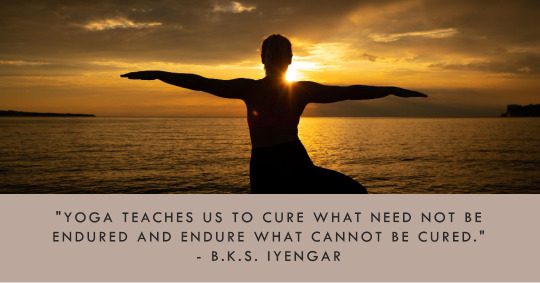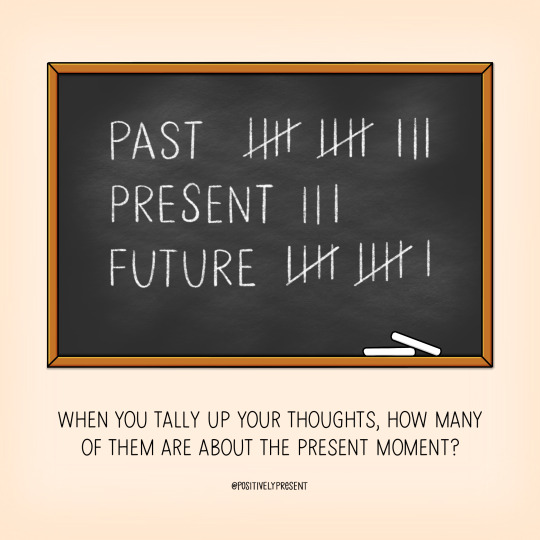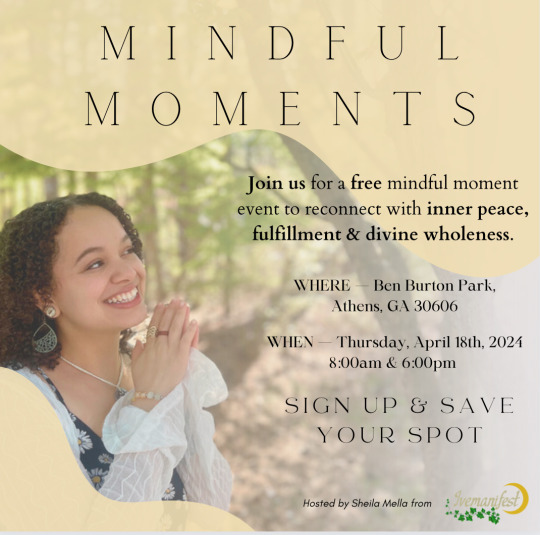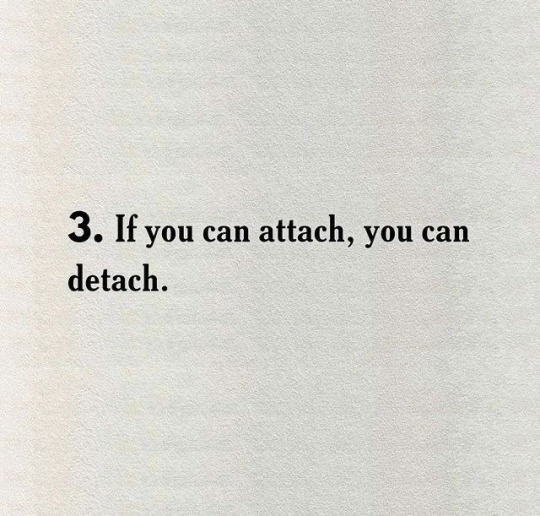#mindfulpractices
Explore tagged Tumblr posts
Text
Discover the Transformative Power of Mindfulness
Mindfulness is a powerful practice that helps manage stress, reduce anxiety, and foster self-awareness. By tuning into your thoughts, feelings, and surroundings without judgment, you can improve emotional regulation, focus, and mental clarity.
Scientific studies show mindfulness meditation can reshape your brain, enhancing emotional resilience and reducing stress. If traditional meditation feels challenging, try creative techniques like sensory storytelling or mindful gardening to cultivate presence in your daily life.
Want to learn more? Read my full article on Substack for insights into mindfulness benefits and techniques. Subscribe for free to support my work and receive new posts!

#mindfulness#mentalhealth#stressrelief#selfcare#anxietyrelief#emotionalresilience#meditation#mindfulpractices#selfawareness#personalgrowth#writer#blogger#blog post#creative writer#newsletter#substack
2 notes
·
View notes
Text
Taoist Mindfulness: Practices for Stress Reduction and Mental Clarity

Hook:
In our fast-paced world, stress and mental fog can cloud our well-being and productivity. Taoist mindfulness, rooted in the ancient teachings of the Tao Te Ching by Lao Tzu, offers profound insights and practices to alleviate stress and achieve mental clarity. By incorporating Taoist principles into our daily routines, we can cultivate a sense of peace, balance, and heightened awareness, fostering a more harmonious existence.
Understanding Taoist Mindfulness:
1. Embracing the Tao (The Way): Taoist mindfulness revolves around aligning with the Tao, the natural order of the universe. By recognizing and flowing with the Tao, we learn to live in harmony with the rhythms of life, reducing resistance and stress.
2. Wu Wei (Effortless Action): Wu Wei, often translated as "effortless action" or "non-doing," is a core Taoist principle. It emphasizes acting in alignment with the natural flow of life, rather than forcing outcomes. This approach helps us handle stress more effectively, allowing solutions to emerge naturally.
3. Yin and Yang Balance: Taoism teaches the balance of yin and yang, the complementary forces in the universe. Mindfulness practices that honor this balance help us navigate life's challenges with grace and composure, reducing stress and promoting mental clarity.
4. The Principle of Emptiness: Emptiness in Taoism is about creating space for new possibilities. By letting go of mental clutter and unnecessary stressors, we open ourselves to clarity and creativity.
Applying Taoist Mindfulness to Daily Life:
1. Mindful Breathing:
Practice: Engage in deep, mindful breathing exercises. Focus on your breath, observing its natural rhythm without trying to control it.
Benefit: Mindful breathing calms the nervous system, reduces stress, and enhances mental clarity.
2. Nature Meditation:
Practice: Spend time in nature, practicing mindfulness by observing the natural world. Sit quietly, listen to the sounds, and watch the movement of leaves, water, or clouds.
Benefit: Nature meditation reconnects us with the Tao, fostering a sense of peace and reducing mental clutter.
3. Wu Wei in Daily Tasks:
Practice: Approach daily tasks with the principle of Wu Wei. Perform actions mindfully and without rushing, allowing them to unfold naturally.
Benefit: This reduces stress by eliminating the pressure to force outcomes, promoting a more relaxed and efficient approach to tasks.
4. Simplification and Decluttering:
Practice: Regularly simplify and declutter your environment and schedule. Remove unnecessary items and commitments.
Benefit: A simplified environment and schedule reduce mental stress and create space for clarity and focus.
5. Yin-Yang Journaling:
Practice: Maintain a journal to reflect on the balance of yin and yang in your life. Note areas where you feel imbalanced and explore ways to restore harmony.
Benefit: Journaling helps identify stressors and imbalances, guiding you toward actions that promote balance and clarity.
6. Taoist Visualization:
Practice: Use visualization techniques to imagine yourself in a state of balance and harmony. Picture stress dissolving and clarity emerging.
Benefit: Visualization reinforces positive mental states and reduces stress by focusing the mind on desired outcomes.
7. Embracing Stillness:
Practice: Dedicate time each day to stillness and silence. Sit quietly, without distractions, allowing your mind to settle.
Benefit: Stillness cultivates inner peace and mental clarity, helping you reset and recharge.
8. Taoist Affirmations:
Practice: Create and repeat affirmations based on Taoist principles. Examples include "I flow with the Tao," "I embrace effortless action," and "I find balance in all things."
Benefit: Affirmations reinforce a mindful and balanced mindset, reducing stress and promoting clarity.
Practical Toolkit for Incorporating Taoist Mindfulness:
1. Morning Mindfulness Routine:
Practice: Start your day with a 10-minute mindfulness routine. This can include mindful breathing, nature meditation, or silent sitting.
Benefit: Beginning the day with mindfulness sets a calm and focused tone, reducing stress and enhancing clarity.
2. Mindful Breaks:
Practice: Take mindful breaks throughout the day. Step away from work, engage in deep breathing, or observe nature for a few minutes.
Benefit: Mindful breaks help reset your mind, reducing stress and maintaining mental clarity.
3. Evening Reflection:
Practice: End your day with a brief reflection. Review your day, noting moments of stress and clarity. Practice gratitude for positive experiences.
Benefit: Evening reflection promotes a peaceful end to the day, helping you identify stressors and appreciate moments of clarity.
4. Mindful Movement:
Practice: Incorporate mindful movement practices such as Tai Chi or Qigong into your routine. Focus on the flow and feel of each movement.
Benefit: Mindful movement harmonizes body and mind, reducing stress and enhancing mental clarity.
5. Digital Detox:
Practice: Schedule regular digital detox periods. Disconnect from electronic devices and engage in mindful activities.
Benefit: Reducing digital distractions lowers stress levels and promotes mental clarity.
6. Tea Meditation:
Practice: Practice tea meditation by preparing and drinking tea mindfully. Focus on the sensory experience and the present moment.
Benefit: Tea meditation provides a simple yet profound way to incorporate mindfulness into daily life, reducing stress and fostering clarity.
7. Mindful Eating:
Practice: Eat meals mindfully, savouring each bite and paying attention to flavors, textures, and the act of eating.
Benefit: Mindful eating enhances the enjoyment of food, reduces stress, and promotes digestive health.
Looking Ahead:
Taoist mindfulness, rooted in the teachings of the Tao Te Ching, offers timeless practices for reducing stress and achieving mental clarity. By embracing principles such as Wu Wei, balance, and simplicity, we can navigate the complexities of modern life with grace and composure. The practical toolkit provided here offers accessible ways to integrate these ancient teachings into daily routines, promoting well-being and a harmonious state of mind. Embrace Taoist mindfulness and discover the profound transformation it can bring to your life.
#TaoistMindfulness#TaoTeChing#StressReduction#MentalClarity#WuWei#InnerPeace#MindfulLiving#SpiritualGrowth#Harmony#BalancedLife#DailyMindfulness#ZenLife#NatureMeditation#MindfulPractices#WellBeing
0 notes
Text
What is mindfulness?
Mindfulness is a mental practice that involves focusing your attention on the present moment in a non-judgmental manner. It's about being fully engaged in whatever you're doing, without being reactive or overwhelmed by external or internal events that can divert your attention.
Here are some key aspects of mindfulness:
Present Moment Awareness: Mindfulness emphasizes staying present and fully participating in the current moment, rather than ruminating about the past or worrying about the future.
Non-judgment: It encourages observing your thoughts and feelings without labeling them as good or bad. Instead of reacting to these thoughts or feelings, you just notice them.
Acceptance: Mindfulness involves recognizing things as they are, without trying to change them. This doesn't mean resignation or apathy, but rather observing things without resistance.
Observation: A cornerstone of the practice is to attentively observe your own thoughts, emotions, and sensations without getting caught up in them.
Non-attachment: This means not getting overly attached to particular outcomes or experiences, but instead letting things come and go naturally.
Beginner's Mind: Mindfulness promotes approaching life with the curiosity and wonder of a beginner, as if experiencing things for the first time.
The practice of mindfulness can be cultivated through various means, including but not limited to:
Mindfulness Meditation: This involves sitting in a quiet place and bringing your full attention to your breath, body sensations, or a particular object. When your mind wanders (and it will), you gently bring it back to the present moment.
Body Scan: This is a form of meditation where you mentally scan your body from head to toe, observing sensations without judgment.
Mindful Eating: Eating slowly and savoring each bite, while fully experiencing the taste, texture, and smell of the food.
Mindful Walking: Walking slowly and deliberately, paying attention to every step and the sensation of movement and touch.
Regular mindfulness practice has been linked to numerous benefits, including reduced stress, improved concentration, better emotional regulation, increased self-awareness, and even improvements in physical health. Research has shown its effectiveness in treating various conditions, such as anxiety, depression, and chronic pain.
#mindfulness#presentmoment#meditation#mentalwellbeing#selfawareness#mindfulpractices#nonjudgment#acceptance#mindfulmeditation#bodyscan#mindfuleating#mindfulwalking#stressrelief#emotionalregulation#beginnersmind#mentalhealth#mindfulbenefits#dailypractice#selfcare#innerpeace
1 note
·
View note
Text

🩹🧘♂️ Experience Healing Through Yoga after Injury! 💪 Gentle rehabilitation & mindful practices aid recovery. Embrace self-awareness & empower your body's natural healing. Join us on this transformative path of resilience & well-being. 🌟
#YogaHealing#MindBodyConnection#InnerStrength#RecoveryJourney#MindfulPractices#InjuryRehabilitation#EmpowerYourHealing#HolisticWellness#StrengthAndResilience#YogaForRecovery#NamasteHealing
0 notes
Text

Try your best to stay present!
#positivelypresent#bepresent#be present#stay present#into the moment#be in the moment#live in the moment#mindfulpractice#mindfulmoment#mindfulness#mindfulthinking
174 notes
·
View notes
Text
A deep dive into still waters: How to self-soothe in waves of Whoosh - Part 3
Therapeutic Models and Self-Soothing
Therapeutic models provide structured approaches to understanding and managing difficult emotions like jealousy. This section offers an overview of some key models—Cognitive-Behavioral Therapy (CBT), Dialectical Behavior Therapy (DBT), and mindfulness-based approaches—and how they inform the techniques you’ll explore in the next section on practical self-soothing strategies.
It’s worth noting that while these models can be very effective for many people, they don’t work for everyone. Therapeutic approaches like CBT, in particular, are sometimes critiqued for focusing on individual emotional regulation rather than addressing broader, systemic or relational issues that may contribute to distress. This doesn’t make these techniques ineffective, but it’s important to recognise that self-soothing practices often form part of a larger emotional toolkit, which may include exploring the social, structural, and relational contexts of your emotions.
A. Cognitive-Behavioral Therapy (CBT)
Cognitive-Behavioral Therapy (CBT) focuses on identifying and challenging negative thought patterns, which are often at the root of intense emotions like jealousy. CBT offers two main contributions to self-soothing:
Thought Restructuring: This technique helps you challenge automatic thoughts, such as “I’m not enough” or “My partner prefers someone else,” and replace them with more balanced perspectives. Thought restructuring, as discussed further in Section IV, can be combined with other grounding or relaxation techniques to break emotional spirals.
However, it’s important to acknowledge that CBT primarily addresses internal thought patterns and behaviours, which can sometimes feel inadequate for those dealing with deeper, external challenges—such as relational dynamics or broader societal pressures—that contribute to distress.
Behavioral Activation: Engaging in positive activities to disrupt rumination is another cornerstone of CBT. This technique encourages you to replace cycles of negative thinking with activities that promote well-being. Section IV will delve deeper into how to incorporate these activities into your daily routine, particularly when managing emotions like jealousy.
Though helpful for many, it’s crucial to recognise that the focus on individual behaviour change can sometimes overlook the relational or contextual factors that influence emotional experiences. CBT’s approach might not resonate with everyone, particularly those looking to address more systemic or interpersonal elements of their emotional responses.
B. Dialectical Behavior Therapy (DBT)
Dialectical Behavior Therapy (DBT) teaches emotional regulation skills that help you tolerate and manage overwhelming emotions like jealousy. Two core contributions of DBT include:
Distress Tolerance Skills: Techniques like the TIPP strategy (Temperature, Intense Exercise, Paced Breathing, Progressive Relaxation) offer immediate relief from acute emotional distress. You can explore detailed application of these techniques in Section IV, which includes guidance on creating a personalised toolkit.
Emotional Regulation: DBT also emphasizes building long-term emotional resilience by incorporating positive emotional experiences and learning to check the facts of a situation. This ties into Section IV’s discussion of regular emotional check-ins and long-term strategies for self-soothing.
C. Mindfulness-Based Approaches
Mindfulness-based approaches, including mindfulness meditation and loving-kindness meditation, focus on staying present and cultivating compassion for yourself and others. These practices allow you to observe emotions without becoming overwhelmed by them.
Mindfulness Meditation: Practicing mindfulness helps you stay grounded during moments of emotional distress. Section IV will cover how to integrate mindfulness into your self-soothing toolkit for both immediate relief and long-term resilience.
Loving-Kindness Meditation: This practice encourages compassion and reduces emotional pain, particularly when dealing with jealousy or insecurity. Further details on how to incorporate loving-kindness into your daily routine can be found in Section IV, where we explore its role in daily self-soothing practices.
D. Somatic Experiencing and Embodied Practices
Somatic experiencing focuses on the connection between the mind and body. Techniques like grounding and breathwork help release physical tension associated with distress.
Grounding Techniques and Breathwork: These methods calm the nervous system by bringing attention back to the body and breath. Section IV provides step-by-step guidance on using grounding and breathwork in real time to manage distress and reduce physical symptoms of emotional overload.
Overview of this Guide
Introduction
The Neuroscience of Self-Soothing Understand how the brain processes emotions and how self-soothing techniques can help rewire emotional responses.
Therapeutic Models and Self-Soothing Techniques Explore structured approaches like CBT, DBT, mindfulness, and somatic practices to manage overwhelming emotions.
Practical Approaches to Self-Soothing Learn step-by-step methods for building a self-soothing toolkit and applying techniques during emotional surges.
Understanding and Integrating Your Experience Discover how to use self-reflection, journaling, and self-compassion to understand emotional patterns and improve resilience.
Conclusion: Embracing the Process A reminder that self-soothing is an ongoing journey of building emotional resilience and finding balance.
#enm#polyamory#ethical non monogamy#personal growth#SelfCare#EmotionalSupport#Grounding#MindfulPractice#PolyamoryAdvice#SelfSoothing
4 notes
·
View notes
Text

Sharing this here if by chance any of my followers are from Georgia! I am hosting a free event on Thursday guiding you through a spiritual mindful moment ✨🧡
Save your spot here
#spirituality#manifestation#spiritualgrowth#how to manifest#law of manifestation#self improvement#positivity#manifestingmiracles#manifestyourreality#law of attraction#mindfulpractice#mindfulness#athens georgia#athens#georgia
2 notes
·
View notes
Text
📝 𝐌𝐢𝐧𝐝𝐟𝐮𝐥 𝐝𝐚𝐥𝐚𝐦 𝐌𝐞𝐧𝐮𝐧𝐭𝐮𝐭 𝐈𝐥𝐦𝐮 𝐒𝐲𝐚𝐫'𝐢
Teringat memori lama yang dirindukan hangatnya. Masa dimana awal-awal ngaji. Masa dimana menuntut ilmu syar'i begitu mendebarkan dan menggairahkan. Rasanya duduk di taman syurga begitu menenangkan. Meski ada kalanya otak belum mampu memahami, tapi hati benar-benar membutuhkannya♡
Di masa itu rasaya seperti semua ingin dipelajari, semua ingin dikuasai, semua kajian ingin dihadiri.
Lalu seiring waktu disadarkan bahwa 𝗱𝗮𝗹𝗮𝗺 𝗯𝗲𝗹𝗮𝗷𝗮𝗿 𝗸𝗶𝘁𝗮 𝗯𝘂𝘁𝘂𝗵 𝗺𝗲𝗺𝗶𝗹𝗮𝗵 𝗺𝗮𝗻𝗮 𝘆𝗮𝗻𝗴 𝗺𝗲𝗻𝗷𝗮𝗱𝗶 𝗽𝗿𝗶𝗼𝗿𝗶𝘁𝗮𝘀. Akhirnya memilah, yang penting saat itu kajian tiap hari.
Sampai menyadari,
𝙈𝙞𝙣𝙙𝙛𝙪𝙡...
Sepertinya, bukan perihal tiap hari hadir kajian gitu aja tapi kelarnya gak tau apa-apa (ಡ‸ಡ), melainkan 𝘁𝗶𝗮𝗽 𝗵𝗮𝗿𝗶 𝗵𝗮𝗿𝘂𝘀 𝗯𝗲𝗿𝘀𝗮𝗺𝗮 𝗶𝗹𝗺𝘂. Karena kita membutuhkannya dari bangun tidur hingga tidur lagi.
Yaa, kita butuh bersama ilmu tiap hari entah itu 𝗺𝗲𝗻𝗱𝗲𝗻𝗴𝗮𝗿𝗸𝗮𝗻, 𝗺𝗲𝗻𝗰𝗮𝘁𝗮𝘁, 𝗺𝗲𝗻𝗲𝗹𝗮𝗮𝗵, 𝗺𝗲𝗺𝗯𝗮𝗰𝗮, 𝗺𝗲𝗻𝗴𝗵𝗮𝗳𝗮𝗹, 𝗱𝗮𝗻 𝗺𝗲𝗺𝘂𝗿𝗼𝗷𝗮𝗮𝗵𝗻𝘆𝗮.
Mindful. Gak berlalu gitu ajaa.
Yang hingga menjelang kita tidur tak ingat apa yang hari ini sudah dipelajari🥀
Rasulullah Shalallahu’alaihi Wasallam bersabda, “Orang yang dikehendaki oleh Allah untuk mendapatkan kebaikan, akan dimudahkan untuk memahami ilmu agama” (HR. Bukhari-Muslim)
Sebagaimana peribahasa orang arab:
“𝙊𝙧𝙖𝙣𝙜 𝙮𝙖𝙣𝙜 𝙢𝙚𝙣𝙜𝙖𝙢𝙖𝙡𝙠𝙖𝙣 𝙖𝙥𝙖 𝙮𝙖𝙣𝙜 𝙩𝙚𝙡𝙖𝙝 𝙞𝙖 𝙞𝙡𝙢𝙪𝙞, 𝙢𝙖𝙠𝙖 𝘼𝙡𝙡𝙖𝙝 𝙖𝙠𝙖𝙣 𝙢𝙚𝙬𝙖𝙧𝙞𝙨𝙞𝙣𝙮𝙖 𝙞𝙡𝙢𝙪 𝙮𝙖𝙣𝙜 𝙗𝙚𝙡𝙪𝙢 𝙞𝙖 𝙞𝙡𝙢𝙪𝙞”
Peribahasa ini dibenarkan oleh firman Allah Ta’ala yang artinya: “Bertaqwalah kepada Allah, maka Allah akan membuatmu berilmu. Sungguh Allah Maha Kuasa atas segala sesuatu” [Al Baqarah: 272] ➡️ ngutip dari Ustadz Yulian Purnama hafizhahullah
(⌒▽⌒)
•••
𝘠𝘢𝘢 𝘪𝘯𝘪 𝘤𝘶𝘢𝘱 𝘱𝘢𝘨𝘪 𝘩𝘪𝘩𝘪. 𝘛𝘪𝘣𝘢-𝘵𝘪𝘣𝘢 𝘴𝘢𝘫𝘢 𝘬𝘦𝘱𝘪𝘬𝘪𝘳𝘢𝘯 𝘮𝘪𝘯𝘥𝘧𝘶𝘭 𝘥𝘢𝘭𝘢𝘮 𝘣𝘦𝘳𝘬𝘢𝘫𝘪𝘢𝘯. 𝘒𝘢𝘳𝘦𝘯𝘢 𝘳𝘢𝘴𝘢𝘯𝘺𝘢𝘢 𝘣𝘢𝘯𝘺𝘢𝘬 𝘺𝘢𝘯𝘨 𝘵𝘦𝘳𝘭𝘦𝘸𝘢𝘵𝘪, 𝘬𝘢𝘭𝘢𝘶 𝘥𝘪 𝘵𝘢𝘯𝘺𝘢 𝘰𝘳𝘢𝘯𝘨 𝘣𝘪𝘯𝘨𝘶𝘯𝘨 𝘴𝘦𝘯𝘥𝘪𝘳𝘪 𝘱𝘢𝘥𝘢𝘩𝘢𝘭 𝘶𝘥𝘢𝘩 𝘥𝘪𝘱𝘦𝘭𝘢𝘫𝘢𝘳𝘪 𝘣𝘢𝘩𝘬𝘢𝘯 𝘣𝘦𝘳𝘬𝘢𝘭𝘪-𝘬𝘢𝘭𝘪. 𝙋𝙖𝙙𝙖𝙝𝙖𝙡 𝙞𝙡𝙢𝙪 𝙞𝙩𝙪 𝙮𝙖𝙣𝙜 𝙢𝙖𝙨𝙪𝙠 𝙨𝙖𝙢𝙥𝙖𝙞 𝙠𝙚 𝙝𝙖𝙩𝙞 𝙜𝙖𝙠 𝙨𝙚𝙠𝙚𝙙𝙖𝙧 𝙨𝙖𝙢𝙥𝙖𝙞 𝙙𝙞 𝙘𝙖𝙩𝙖𝙩𝙖𝙣. 𝘿𝙖𝙣 𝙞𝙡𝙢𝙪 𝙮𝙖𝙣𝙜 𝙗𝙚𝙧𝙢𝙖𝙣𝙛𝙖𝙖𝙩 𝙞𝙩𝙪 𝙮𝙖𝙣𝙜 𝙨𝙖𝙢𝙥𝙖𝙞 𝙢𝙚𝙢𝙗𝙪𝙖𝙝𝙠𝙖𝙣 𝙖𝙢𝙖𝙡.
Semoga Allah memudahkan kita untuk menuntut ilmu, memahaminya, dan mengamalkannya, aamiin allahumma aamiinn
___
Jogja, 24 Januari 2024
#motivation#ntms#self reminder#note to self#mindfulpractice#mindfulawareness#mindfulness#assunnah#being mindful#menuntut ilmu
5 notes
·
View notes
Text
💕💕

20K notes
·
View notes
Text

Yoga is more than just a workout; it’s a way of life. Celebrate International Yoga Day by embracing wellness. Yoga promotes balance, peace, and clarity in everyday life. Take time for yourself today.
visit http://www.avlasthydrocolloids.com%20/
0 notes
Text
Finding Presence in a Distracted World.
You pick up your phone to check the time... 20 minutes later, you're deep in a scroll, having completely forgotten why you reached for the device. Sound familiar?
In our hyperconnected world, being truly present has become increasingly rare and increasingly valuable. As someone who struggles with this daily, I've been exploring simple ways to return to the moment without adding more pressure to an already full life.
Why Presence Matters Now
Our attention is constantly pulled in multiple directions. Technology designed to capture our focus, the myth of productive multitasking, and our own racing thoughts create the perfect storm for disconnection.
This constant overstimulation keeps our nervous systems in a subtle state of alert, manifesting as scattered attention, mental fatigue, and a sense of watching our lives rather than living them.
True presence isn't about achieving perfect calm. It's simply the practice of noticing where you are right now. A gentle awareness of "here I am" in this body, at this moment, with whatever thoughts and feelings are moving through.
Three Simple Practices to Try Today
Through much trial and error, I've found these approaches make presence more accessible:
1. Start your day device-free for 15 minutes
When we reach for our phones first thing, we hand over our attention before we've even fully awakened. Instead, try taking those first moments to breathe, stretch, or simply look out the window.
2. Use the 5-4-3-2-1 grounding technique
When feeling particularly scattered, this quick exercise helps:
Notice 5 things you can see
Notice 4 things you can touch
Notice 3 things you can hear
Notice 2 things you can smell
Notice 1 thing you can taste
3. Create one tech-free zone
Designate one area of your home or one hour of your day as completely screen-free. This simple boundary creates space for your attention to reset and reconnect.
The Gentle Art of Coming Back
If there's one thing I've learned about presence, it's that drifting away is inevitable. The practice isn't about preventing the wandering—it's about how kindly you bring yourself back.
When you notice you've drifted, try meeting yourself with the same compassion you'd offer a friend who got momentarily lost. No scolding necessary, just a gentle redirect back to now.
Every moment of presence is a small chapter in your healing story. Each return to now is a tiny act of self-care that, over time, accumulates into a life that feels more awake and more fully yours.
Want to explore more practical ways to cultivate presence in everyday life? Read the full article on Healing Chapters where I share three additional practices, journal prompts, and the deeper benefits I've discovered through this ongoing journey.
1 note
·
View note
Text

🧘♀️ Yoga Do's and Don'ts 🧘♂️
Practice with patience, breathe deeply, and always listen to your body. Consistency is key, and remember—this journey is yours. Don’t rush, don’t compare, just embrace the flow. 🌿
Start your yoga journey with us at Rishikesh Yoga School ✨
#YogaJourney#MindfulPractice#YogaDo’sAndDont’s#RishikeshYoga#BreatheAndFlow#YogaConsistency#YogaForLife#SelfAwareness#YogaInspiration#RishikeshYogaSchool#FindYourBalance
0 notes
Text
respirar habitualmente de forma más lenta es uno de los secretos del bienestar. Puede parecer fácil, pero la realidad es que normalmente hacemos lo contrario.
0 notes
Text
#MindfulnessJourney#MindfulLiving#PresentMoment#MindfulAwareness#MindfulPractice#MindfulnessMatters#MindfulLife#MindfulMovement#MindfulCommunity#MindfulMoments
0 notes
Text
🩹🧘♂️ Experience Healing Through Yoga after Injury! 💪 Gentle rehabilitation & mindful practices aid recovery. Embrace self-awareness & empower your body's natural healing. Join us on this transformative path of resilience & well-being. 🌟
#YogaHealing#RecoveryJourney#MindfulPractices#InjuryRehabilitation#EmpowerYourHealing#HolisticWellness#StrengthAndResilience#YogaForRecovery#NamasteHealing
0 notes
Text

Read the blog post for more tips on how to stay present. And get Into the Moment here!
#positivelypresent#bepresent#mindfulpractice#stay present#mindfulmoment#be here now#mindfulthinking#be present#into the moment
142 notes
·
View notes